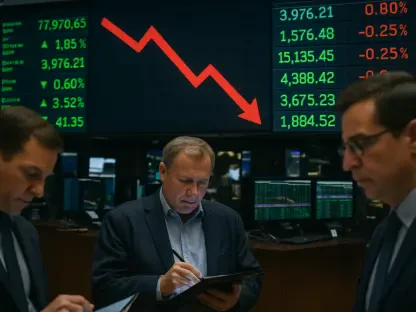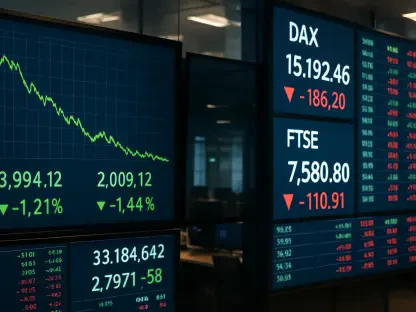Brazil is entering a transformative phase in its cryptocurrency sector as Banco Central do Brasil unveils a sweeping set of regulations that promise to reshape the industry in South America’s largest economy. Announced on November 11, 2025, these guidelines, effective from February 2, 2026, introduce a structured framework for a market that has long operated with minimal oversight. With a nine-month compliance window for existing firms, the central bank aims to balance innovation with stringent security measures. This development raises critical questions about the future of digital assets in Brazil, as the balance between fostering growth and imposing control becomes a focal point of discussion. While the intent is to enhance transparency and curb risks such as money laundering, the strict rules have sparked a heated debate among industry stakeholders who fear the potential dampening of competition and accessibility for smaller players. The coming months will reveal how this regulatory shift influences the vibrant crypto landscape.
Regulatory Framework and Oversight
Licensing and Compliance for VASPs
The cornerstone of Brazil’s new crypto regulations lies in the establishment of a formal licensing regime for Virtual Asset Service Providers (VASPs), fundamentally altering how businesses operate within the sector. These entities are now classified into three distinct categories—intermediaries, custodians, and brokerages—and must secure approval from the central bank to legally function. Compliance demands include implementing robust cybersecurity protocols and conducting thorough customer due diligence, ensuring that only firms meeting high standards can participate. This shift from a largely unregulated space to a tightly governed one is intended to protect consumers and stabilize the market. However, the complexity of these requirements could pose significant hurdles for companies unaccustomed to such oversight, potentially limiting the diversity of players in the field. The central bank’s rigorous approach underscores a commitment to security, but it also sets a high bar that not all businesses may be able to reach without substantial resources or restructuring.
Beyond the licensing structure, the regulations mandate that foreign companies establish local entities to align with Brazilian jurisdiction, adding another layer of complexity to market entry. This requirement ensures that international firms are subject to the same oversight as domestic ones, leveling the playing field in terms of compliance. Yet, it also raises concerns about the feasibility for smaller or less capitalized foreign players who may find the cost and logistical challenges of setting up local operations prohibitive. The focus on cybersecurity and risk assessment further emphasizes the central bank’s priority to safeguard the financial ecosystem from digital threats. While these measures are designed to build trust in the crypto market, they could inadvertently exclude innovative startups that lack the infrastructure to meet such demands. As the February 2026 deadline approaches, the industry watches closely to see how many firms can navigate this intricate compliance landscape without sacrificing their operational agility or market presence.
Integration with Financial Systems
One of the most significant aspects of the new framework is the integration of cryptocurrency transactions into Brazil’s existing foreign exchange and capital market regulations, marking a pivotal shift in oversight. This alignment aims to provide greater visibility into how digital assets influence the nation’s economic metrics, such as balance of payments. Starting May 4, 2026, firms must submit monthly reports on international transactions, detailing client information, asset types, and amounts, with a cap of $100,000 per transaction. Such measures are crafted to minimize regulatory arbitrage and ensure that crypto activities do not undermine financial stability. However, this level of scrutiny could place an administrative burden on VASPs, particularly those with high transaction volumes. The central bank’s intent to monitor cross-border flows is clear, yet the practical implications for businesses adapting to these reporting standards remain a point of contention in the industry.
Additionally, tying crypto dealings to traditional financial systems reflects a broader global trend of treating digital assets as part of mainstream economic frameworks, rather than standalone entities. This approach enables the central bank to track and manage potential risks like illicit capital outflows or tax evasion, which have long been associated with cryptocurrencies. However, the integration also challenges the decentralized ethos that defines much of the crypto space, potentially alienating purists who value autonomy over regulation. For businesses, the need to adapt systems for compliance with foreign exchange rules may require significant investment in technology and personnel training. As the implementation date nears, the focus will likely shift to how effectively VASPs can balance these new obligations with maintaining user trust and operational efficiency. The central bank’s strategy, while comprehensive, will test the resilience of a sector accustomed to operating with fewer constraints.
Financial and Operational Challenges
High Capital Requirements
A particularly contentious element of Brazil’s crypto regulations is the substantial capital requirements imposed on VASPs, ranging from 10.8 million reais (about $2 million) to 37.2 million reais (approximately $7 million). These thresholds, significantly higher than those floated during earlier consultations, are designed to ensure that only financially robust entities operate in the market, thereby reducing the risk of insolvency or fraud. The central bank views this as a critical safeguard for consumer protection and market stability. However, critics, including industry advocates, argue that such high barriers to entry could exclude smaller firms and startups, which often drive innovation in the crypto space. This financial hurdle might lead to a market dominated by larger, well-capitalized players, potentially stifling the competitive diversity that has characterized Brazil’s digital asset sector. The long-term impact on market dynamics remains uncertain as the compliance deadline looms.
Moreover, the capital requirements could trigger a wave of consolidation within the industry, as smaller VASPs may seek mergers or partnerships with larger entities to meet the financial criteria. This reshaping of the competitive landscape might limit consumer choice and concentrate market power among a few dominant firms, a concern echoed by groups like the Brazilian Association of Cryptoeconomy (ABCripto). The central bank’s rationale hinges on creating a safer environment, yet the risk of reduced innovation looms large, especially in a field where agility and creativity are key drivers of growth. For many smaller players, securing the necessary funds within the tight compliance window adds further pressure, potentially forcing some out of the market entirely. As the sector braces for these changes, the balance between ensuring stability and preserving an inclusive market will be a critical measure of the regulations’ success in fostering a sustainable crypto ecosystem.
Operational Restrictions and AML Measures
The new regulations also introduce strict operational constraints on VASPs, reflecting a strong emphasis on mitigating financial crime risks within the crypto sector. Notably, firms are prohibited from handling physical currency—whether domestic or foreign—for crypto transactions, a measure aimed at curbing money laundering and illicit cash flows. Additionally, transactions involving self-custody wallets are now subject to foreign exchange controls, aligning them with broader cross-border capital regulations. These restrictions underscore the central bank’s intent to impose tight oversight on how digital assets are exchanged and stored. While the goal is to enhance security, such limitations may challenge the flexibility that many users and businesses value in cryptocurrencies, potentially impacting adoption rates among those who prioritize decentralization. The operational landscape for VASPs is thus set to become more rigid, raising questions about adaptability.
In parallel, the framework incorporates robust anti-money laundering (AML) protocols, requiring VASPs to implement stringent monitoring and reporting mechanisms to detect and prevent suspicious activities. This focus on AML compliance aligns with global efforts to address the misuse of cryptocurrencies for illegal purposes, yet it places additional operational burdens on firms already grappling with licensing and capital demands. The need to invest in compliance infrastructure, such as advanced transaction tracking systems, could strain resources, especially for smaller entities. Furthermore, these measures might alter the user experience, as heightened scrutiny could lead to delays or increased verification steps during transactions. As the central bank prioritizes safeguarding the financial system, the industry must navigate how to maintain efficiency and user satisfaction under these new constraints. The effectiveness of these AML efforts will likely be a key determinant of public and regulatory confidence in Brazil’s evolving crypto market.
Industry Reactions and Timeline Pressures
Stakeholder Concerns and Industry Impact
As Brazil’s central bank rolls out its comprehensive crypto regulations, reactions from industry stakeholders reveal a divide between regulatory intent and market realities. Gilneu Vivan, the director of regulation, has emphasized the importance of balancing innovation with security, highlighting the role of technology in ensuring compliance with obligations like AML protocols. However, industry voices, particularly from ABCripto, express apprehension over the high capital thresholds and strict rules, arguing that they could hinder sector growth. This tension mirrors a global debate on how to govern cryptocurrencies without curbing their potential to drive economic and technological advancement. The central bank’s cautious stance prioritizes stability, but at the risk of alienating smaller players who may struggle to meet the new standards. The coming months will test whether this framework can accommodate diverse business models or if it will inadvertently favor established firms.
Furthermore, the broader impact on Brazil’s crypto industry could set a precedent for other emerging economies grappling with similar regulatory challenges. If the high barriers to entry lead to market consolidation, as some predict, the diversity of offerings and competitive pricing that benefit consumers might diminish. Industry advocates warn that innovation, a hallmark of the crypto space, could take a backseat to compliance costs and operational hurdles. The central bank’s perspective, focused on consumer protection and financial integrity, is understandable, yet the potential for reduced market dynamism remains a significant concern. As global attention turns to Brazil’s approach, the outcome of this regulatory experiment could influence how other nations craft their own policies. The dialogue between regulators and industry players will be crucial in shaping a framework that supports both security and the entrepreneurial spirit that defines the digital asset sector.
Tight Compliance Deadline
The nine-month compliance window, set to conclude by late 2026, has emerged as a critical pain point for crypto firms operating in Brazil, adding urgency to an already challenging transition. Existing businesses must rapidly align with the new capital, operational, and cybersecurity standards, a task that demands significant resources and strategic planning. For many, this tight timeline risks disrupting operations or forcing difficult decisions, such as seeking external funding or scaling back services to meet requirements. The central bank’s determination to enforce order swiftly is evident, yet the feasibility of such a rapid overhaul remains questionable for firms with limited capacity. This deadline pressure could disproportionately affect smaller VASPs, potentially pushing them out of the market if they cannot adapt in time. The industry’s ability to navigate this constraint will be a defining factor in the regulations’ overall impact.
Compounding the challenge, foreign companies face the additional requirement of establishing local entities to comply with Brazilian jurisdiction, a process that further compresses the compliance timeline. Setting up operations in a new market involves legal, logistical, and financial complexities that could delay entry or deter participation altogether. Industry leaders have criticized this aggressive schedule, arguing that it underestimates the practical difficulties of restructuring business models to fit the new framework. The central bank’s focus on expediency aims to minimize prolonged uncertainty in the market, but it risks alienating participants who might otherwise contribute to a vibrant crypto ecosystem. As the deadline approaches, attention will likely center on whether extensions or transitional support will be offered to ease the burden. The resolution of this timeline issue will play a pivotal role in determining how many players remain active in Brazil’s evolving digital asset landscape.









